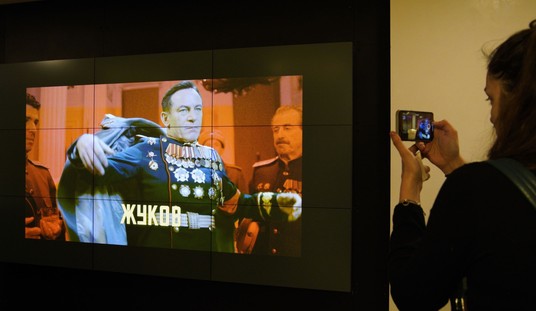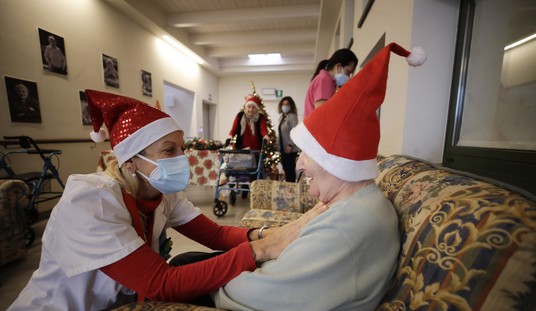“Sunday Reflection” is a regular feature, looking at the specific readings used in today’s Mass in Catholic parishes around the world. The reflection represents only my own point of view, intended to help prepare myself for the Lord’s day and perhaps spark a meaningful discussion. Previous Sunday Reflections from the main page can be found here. For previous Green Room entries, click here.
This morning’s Gospel reading is John 20:19–31
On the evening of that first day of the week, when the doors were locked, where the disciples were, for fear of the Jews, Jesus came and stood in their midst and said to them, “Peace be with you.” When he had said this, he showed them his hands and his side. The disciples rejoiced when they saw the Lord. Jesus said to them again, “Peace be with you. As the Father has sent me, so I send you.” And when he had said this, he breathed on them and said to them, “Receive the Holy Spirit. Whose sins you forgive are forgiven them, and whose sins you retain are retained.”
Thomas, called Didymus, one of the Twelve, was not with them when Jesus came. So the other disciples said to him, “We have seen the Lord.” But he said to them, “Unless I see the mark of the nails in his hands and put my finger into the nailmarks and put my hand into his side, I will not believe.”
Now a week later his disciples were again inside and Thomas was with them. Jesus came, although the doors were locked, and stood in their midst and said, “Peace be with you.” Then he said to Thomas, “Put your finger here and see my hands, and bring your hand and put it into my side, and do not be unbelieving, but believe.” Thomas answered and said to him, “My Lord and my God!” Jesus said to him, “Have you come to believe because you have seen me? Blessed are those who have not seen and have believed.”
Now, Jesus did many other signs in the presence of his disciples that are not written in this book. But these are written that you may come to believe that Jesus is the Christ, the Son of God, and that through this belief you may have life in his name.
Earlier today, Pope Francis canonized two of his more recent predecessors, Popes John XXIII and John Paul II. They join in the canon of saints whose life stories of heroic sanctity inspire Catholics and other Christians around the world to greater holiness. One of the more common misconceptions about recognized saints in the Catholic practice is that sainthood requires a life without error or doubt, but even a quick read of some of their life stories dispels that myth rather quickly. St. Augustine of Hippo, one of the doctors of the Church and a towering figure in Christianity, was so addicted to earthly pleasure that he kept delaying his conversion. Jesus Christ Himself is our model of perfect love and worship for God, but the saints teach us much about the human struggle to achieve it.
Saint Thomas’ story in the Gospels provides us with a story of failure that mirrors a universal human response to the challenge of faith itself. Who hasn’t been a “doubting Thomas” at some (perhaps many) stages in our own lives? It is the struggle of faith against the limitations of human reason, the struggle of faith against hopelessness, and the human failing to reject faith in favor of the limitation of our own experience.
It’s not difficult to understand why Thomas remains skeptical in this instance, either. Jesus had been crucified and buried, which would have given most people plenty of reason to consider the movement over. Hearing that a man killed in that matter had returned to life would produce at least a desire for some evidence of the claim from most of us.
On the other hand, this was no ordinary claim, nor an ordinary group. Thomas had seen Jesus raise Lazarus from the dead, and had heard Jesus teach about the need for His death and resurrection to complete his mission. Plus, the other disciples offered their own unanimous testimony to the one man in Jerusalem who should have been relatively easy to evangelize. Thomas rejected all of them, and rejected faith as well. Instead, Thomas demanded that Jesus re-present Himself for inspection before Thomas would give his faith to Jesus.
In short, he wanted to test God, to know rather than believe. This is no different than the Israelites in the desert who kept balking at Moses after the Exodus, or to the Pharisees and Sadducees in Jerusalem in the New Testament who repeatedly tried to test Jesus in a similar manner. Satan tempted Jesus to fail in the same sin during the Temptation in the Desert, challenging Jesus to test God by hurling himself off the mountain and forcing God to send angels to save him. Jesus rebuked Satan, saying, “Again it is written, You shall not put the Lord, your God, to the test.”
Yet, Jesus does not abandon Thomas for his unbelief or for Thomas’ attempt to put Jesus to the test. Rather, He returns again when Thomas is among the disciples in order to correct Thomas. Jesus does scold Thomas and reminds him that the true communion with God is through voluntary belief — but Thomas, rebuked, is also forgiven and brought back into the fold. This to me epitomizes Jesus as shepherd of His flock, especially with those who will shortly go out into the world. Almost all of them had abandoned Him at some time during the Passion, and yet all return to Jesus afterward. Even Thomas, who ends up getting dragged back to faith, is restored to the love of Christ. Almost one by one, Jesus brings them back, just like any good shepherd whose lamb has strayed.
Thomas, as it happens, has quite a life ahead in service to Christ. He travels the farthest, perhaps, of any of the disciples. Thomas ends up in India, where his conversion created a community of Christians that exist to this day. Our family sponsors a Christian family in Kerala, near where Thomas landed and evangelized. Thomas was martyred there according to some traditions (others have him dying a natural death), but his life of heroic sanctity and devotion to Christ in spreading the Gospel makes Thomas an obvious choice as a saint, despite his enduring reputation for doubt based on a single episode between the Resurrection and Pentecost.
So, perhaps that reputation is more than a little unfair — but that prompts another question: Why did John include it in the Gospel? For that matter, why do all four Gospels include the story of Peter denying Christ three times during the Passion? In all four accounts, no other disciple was with Peter, so Peter himself has to be the source, or at the very least approving of the inclusion of this account in the Gospel taught in the earliest days of the Church. Why include stories that make the Apostles look weak, frightened, unbelieving, and even arguably paints them as apostates?
They included these stories because the Gospels speak to us as we are, in all stages of our lives. We see ourselves in these episodes, and we see the Apostles as fully human and frail, just as we all are. These Gospel stories remind us that faith isn’t a one-time simple binary choice, but a life full of daily choices to believe and have faith. We stumble, we doubt, we may even lose courage and try to go with the flow rather than take the risk to live our faith in the public square. Jesus will wait patiently for us to find our way back to Him, and even find His way back to us when we need it. The saints who brought us the Gospel humbled themselves to ensure that we understood, even two millenia later.
The stories of all the saints are filled with these kinds of stumbles, failures, and doubts. The saints, starting with Peter and Thomas and working all the way to John XXIII and John Paul II, don’t lecture us on perfection. The saints beckon us to become their brothers and sisters, and to take heart in their struggles as we deal with our own. They remind us of the enduring love of God and our status as ever-prodigal sons and daughters, with our Father waiting for us to find our way home so that He can include us in the eternal celebration of His love.








Join the conversation as a VIP Member